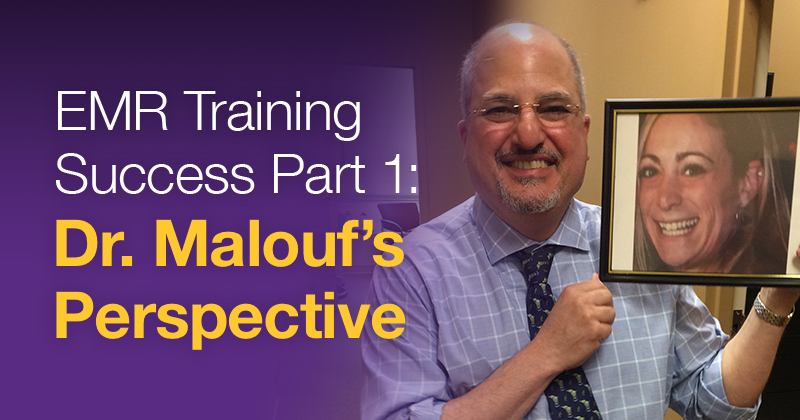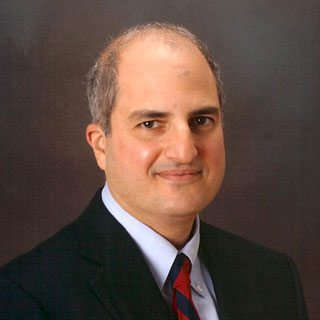Dr. Alan Malouf Shares his Ophthalmology EMR Training Story

To read the full case study with Dr. Alan Malouf, please click here. Or, check out Vimeo for some videos of EMA in action.
I started using Modernizing Medicine’s ophthalmology electronic medical records (EMR) system, EMA™, in October 2015, and I haven’t looked back since. To help out other ophthalmologists who are considering switching from paper or another EMR system, I wanted to share my perspective on the software, the company and the EMR system training experience.
The Backstory
First, let me share a little bit about myself and my ophthalmology practice. I had been handwriting my patient notes for 25 years at my ophthalmology practice in Bowie, Maryland. We had been scanning our paper medical charts to digital PDF files, and my handwriting was becoming harder to read, not to mention this was a time-consuming task. I was coding to the best of my ability but was never 100 percent sure what coding level was appropriate. Also, we didn’t want to be disadvantaged moving forward with compliance issues by the government, so we decided it was time to make a change.
A colleague of mine highly recommended Modernizing Medicine’s EMA ophthalmology EHR system. I saw a demo at one of their company events and was simply blown away. Given that EMA is built by ophthalmologists, cloud-based and not cost prohibitive, I saw no downside to implementing it into my ophthalmology practice. EMA was the first EHR system we had seen that was so well designed for ophthalmologists, so it was an easy decision to move forward with EMA as our solution. We began preparing staff for EHR implementation by taking EMA training courses online and watching EMA training videos.
A Historic Moment: October 2015
As previously mentioned, we went live with EMA in October of 2015, and the transition was unproblematic. We participated in EMR training online for a few weeks and then decided to have a Modernizing Medicine educator visit our practice for two days of onsite medical office software training and EMR tutorials. We followed the EHR training plan protocols she suggested, which established good habits using EMA from the beginning. The education and training for EMR software that we received were so thorough that we were able to continue with our existing patient flow, and our productivity didn’t decrease. Our decision to take advantage of the EHR software training services offered ended up being a smart one.
Raising the Bar
When using this ophthalmology software, I feel like it was built just for me. EMA was designed by actual ophthalmologists to cater to ophthalmic and subspecialty workflows, which makes Modernizing Medicine’s ophthalmology EMR software unique compared to others on the market.
There is no question that EMA has raised the bar for ophthalmology EMRs. Since implementation and EMR training, we have increased productivity and EMA has made us more efficient. Our practice also looks and feels more like a true ophthalmology practice. Before I even walk into the exam room, EMA is populated with the patient’s information. With a few taps on the iPad, I input the exam, ePrescribe if needed and finalize my note before the patient leaves the office. It’s that quick and easy. I see 40-55 patients per day without the use of a scribe. I realize that other ophthalmologists may prefer using a scribe, but I feel it’s incredible that this EMR software doesn’t require one and I can do it all on my own. EMA anticipates my next move, allowing me to focus on treating my patients without interruption to my workflow.
Confidence in Documentation
The structured data that EMA collects automatically generates suggested ICD-10 codes, as well as CPT codes, modifiers and E&M levels, so my staff and I feel confident knowing we will receive payment for services performed and have the proper documentation to back it up.
Prior to using EMA, I completed my own coding, and I wasn’t sure it was done correctly. Now that EMA automatically suggests the codes for our ophthalmology billing, our documentation is much more accurate so we not only save money but also earn more. In addition, the notes that EMA produces exceed my expectations and are superior to any other note on the market. Even colleagues of mine that use other ophthalmology EMRs agree.
Backed by a Team of Experts
When you use a remarkable, well-thought-out ophthalmology EMR like EMA, you likely won’t experience many issues. If we do need support, the Modernizing Medicine team is always responsive. I would recommend EMA to anyone who is considering an ophthalmology EHR system; it was the best decision we ever made.
And click here for Heidi’s side of the story to learn more about our educators and electronic medical records training options.
This post was originally published on August 30, 2016, and was updated on April 26, 2019.
